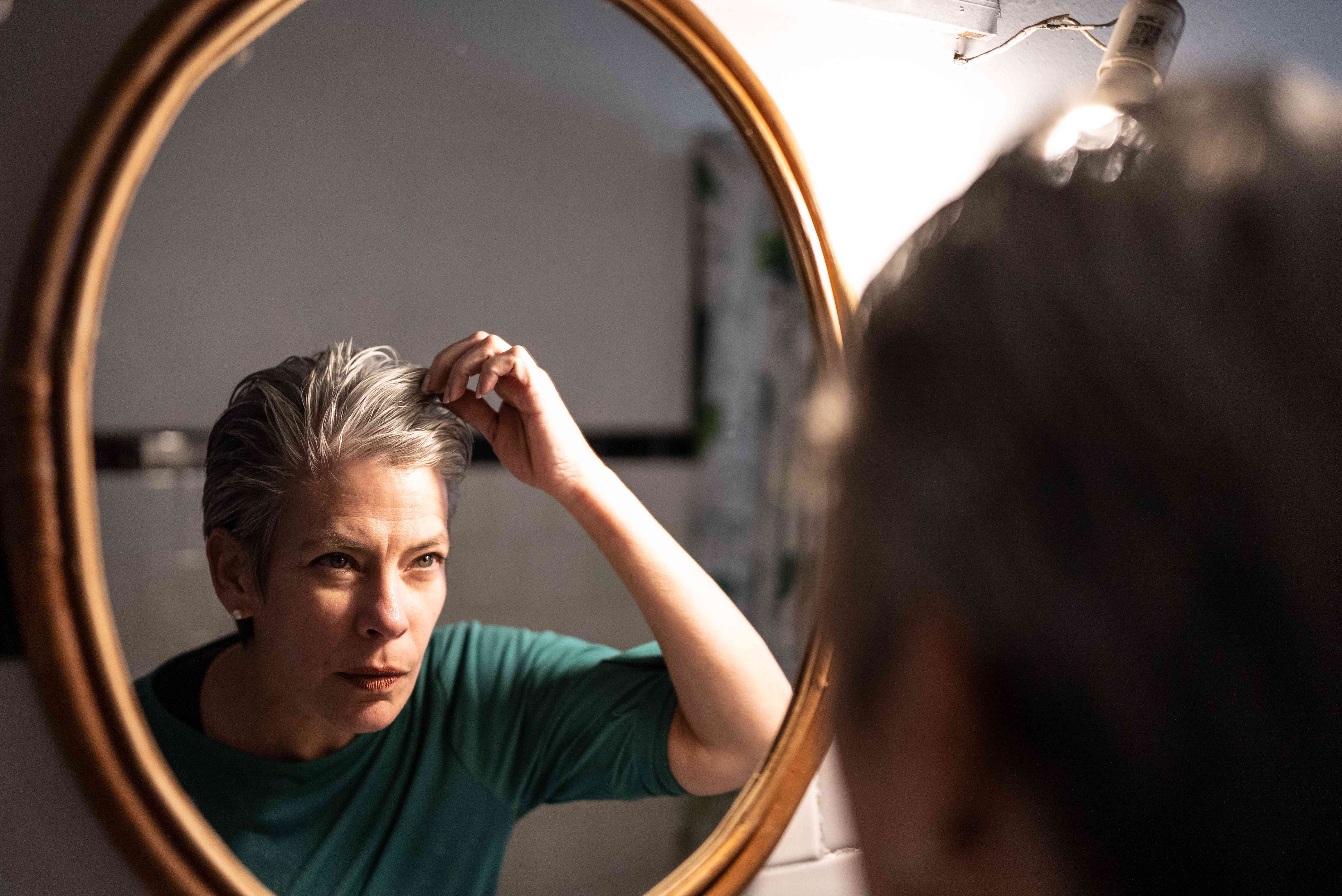Can Your Hair Grow Back After Alopecia?

Losing hair due to alopecia can be a distressing experience, and it’s common to wonder if hair regrowth is possible, but the answer to that varies depending on the type of alopecia you have. 1 However, there are multiple types of alopecia, and the chance of hair regrowth differs based on the specific subtype. 2
How Fast Does Hair Grow Back After Alopecia?
The speed of hair regrowth following an episode of alopecia varies based on individual health factors, type of alopecia, and treatment methods. 2 For those with alopecia areata, new hair can start to grow within six to eight weeks following treatments, such as injected corticosteroids. However, not all people with alopecia areata require treatment.
Some people notice soft, fine hair regrowing on the affected areas initially, which thickens and darkens over time. However, regrowth can be unpredictable, as alopecia areata may come and go throughout a person’s life. Generally, the hair growth rate is about half an inch per month, but full restoration may take longer, especially if the initial hair loss is extensive. 1
Does the Hair Grow Back the Same?
When hair does regrow, it may not initially look the same as it did before the episode of alopecia. Sometimes, the hair grows back with a different pigment or looks more grey at first, but it may gain its original color over time. 1 In rare cases, their hair regrows with a different texture or thickness. 3
For example, hair that was once straight might regrow curly, or vice versa. Patchiness can also occur if not all follicles restart production at the same time. Over time, the hair may return to its usual characteristics, but changes in texture and color are often seen in the early stages of regrowth. 3
Types of Reversible Alopecia
Certain types of alopecia are more likely to allow for hair regrowth. Here’s a breakdown of some reversible forms: 4
- Alopecia areata: This type often leads to patchy hair loss and is usually reversible. Many people see spontaneous regrowth within several months. 1
- Anagen effluvium: This type often affects hair in its growth phase due to chemotherapy or other medical treatments. Hair generally grows back after the treatment ends. 5
- Androgenetic alopecia: This is the most common form of hair loss, often referred to as male-pattern or female-pattern baldness. It is primarily hereditary and typically results in gradual thinning and hairline recession in both men and women. 6 Treatment options that may partially reverse this condition include medications like minoxidil and finasteride. 7
- Alopecia syphilitica: This form is caused by syphilis infection. This form of alopecia results in diffuse hair thinning or patchy hair loss. Treating the underlying syphilis infection may reverse the hair loss. 8
- Telogen effluvium: This type causes diffuse hair thinning, which is triggered by stress, illness, or hormonal changes. It is usually temporary, with hair typically returning to normal within six months once the underlying cause is addressed.
- Traction alopecia: This kind is caused by repeated tension on the hair, often due to hairstyles like tight ponytails, braids, or extensions. Traction alopecia results in hair thinning and breakage, particularly around the hairline. It is usually reversible if the tension is removed early, but long-term tension can lead to permanent hair loss. 9
- Trichotillomania: This type is due to a psychological condition where a person has a compulsion to pull out their hair, leading to patchy hair loss. Often associated with stress or anxiety, treatment typically involves behavioral therapy and sometimes medication. 10
These types of alopecia are called “nonscarring,” meaning the hair follicles remain intact and capable of producing new hair. 11
Non-Scarring vs. Scarring Alopecia
Non-scarring alopecia, like alopecia areata, telogen effluvium, and anagen effluvium, generally allows for potential regrowth since hair follicles remain undamaged. Scarring alopecia, however, involves irreversible damage to the follicles, making regrowth unlikely. Recognizing whether hair loss is scarring or nonscarring can help guide expectations for regrowth. 12
Why Some People Don’t Get Their Hair Back
Some forms of alopecia result in permanent hair loss, often because the hair follicles are damaged or destroyed. This is typical of scarring alopecia, a group of disorders where inflammation damages hair follicles, replacing them with scar tissue. Types of scarring alopecia include:¹³
- Central centrifugal cicatricial alopecia (CCCA): This type primarily affects Black women and often starts at the crown of the scalp. Hair loss is progressive, and regrowth is usually minimal without early intervention.
- Chronic cutaneous lupus erythematosus: An autoimmune condition that causes red, scaly patches on the skin, especially on the scalp, face, and ears. If untreated, these patches can lead to scars and permanent hair loss.
- Lichen planopilaris: This rare, inflammatory condition destroys hair follicles and, if untreated, may lead to permanent hair loss.
With scarring alopecia, it’s essential to consult a dermatologist early for a diagnosis and possible treatments to help manage the condition and potentially preserve the remaining hair. 13
Who’s More Likely to Experience Hair Regrowth?
Several factors can increase the likelihood of hair regrowth after an episode of alopecia, including:¹
- Age: Younger individuals may experience faster regrowth, as younger hair follicles are generally more resilient.
- Alopecia subtype: Nonscarring forms of alopecia offer a better chance of regrowth compared to scarring types.
- Extent of hair loss: Those with limited or mild hair loss are more likely to see regrowth than those with severe or extensive loss.
- Treatment: Timely intervention with appropriate treatments can increase the odds of regrowth, especially for conditions like alopecia areata. 4
Treatments to Stimulate Regrowth
Various treatments are available for those seeking to regrow hair after alopecia. Options vary based on the type of alopecia, but common approaches include ¹⁴
- Janus kinase (JAK) inhibitors: These newer oral medications are showing promise for alopecia areata by targeting specific immune pathways involved in hair loss. However, they may not be suitable for all cases and have potential side effects. 15
- Minoxidil (Rogaine): This FDA-approved topical treatment is commonly used to promote hair regrowth for multiple forms of alopecia, including telogen effluvium and early-stage androgenetic alopecia.
- Oral immunosuppressants: For severe alopecia areata, medications like methotrexate or cyclosporine can be prescribed to suppress the immune system and help prevent further hair loss. 16
- Platelet-rich plasma (PRP): PRP injections involve using your blood’s growth factors to stimulate hair follicles, particularly for androgenetic and areata alopecia.
- Topical or injectable corticosteroids: Often prescribed for alopecia areata, these reduce inflammation around the hair follicles and may encourage regrowth.
Treatments to Slow Progression
In cases where hair loss is ongoing, slowing its progression can help prevent further thinning. Options include:
- Hormonal therapy: Androgenetic alopecia can often be managed with medications that regulate hormones, such as finasteride or spironolactone. 14
- Lifestyle modifications: Ensuring proper nutrition and avoiding harsh hair treatments can help slow hair loss, especially in conditions like telogen effluvium. 14
- Low-level laser therapy (LLLT): Devices using low-level lasers or LEDs may help reduce inflammation and support regrowth in nonscarring types of alopecia. 17
Treating hair loss early may increase the effectiveness of these interventions, so it’s advisable to consult with a dermatologist or healthcare provider at the first signs of significant hair shedding.
When to Contact a Healthcare Provider
If you’re experiencing sudden or unexplained hair loss, it’s best to seek medical guidance. Call your provider if you are experiencing: 18
- Hair loss at an early age, such as in teens or 20s
- Losing hair rapidly
- Losing hair in an unusual pattern
- Pain or itching along with hair loss
- You have a scalp infection
- You have muscle weakness, intolerance to cold, weight gain, or fatigue
- Pain or itching along with hair loss
A dermatologist can perform tests to determine your alopecia type and suggest treatments. Early diagnosis and treatment may help increase your chances of regrowth or slow progression, especially for forms of nonscarring alopecia.







